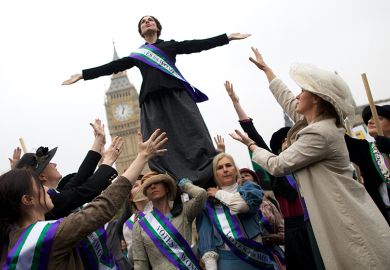For the authors of these two books, the spectacle of the model Nick Kamen striding into a launderette and dropping his jeans in a 1986 advertisement for Levi's stands out as a critical moment in modern cultural history. The model's soft masculinity typified a new mode of male representation that emerged in the 1980s: the "new man". Sean Nixon's Hard Looks and Frank Mort's Cultures of Consumption chart the technological, economic and cultural changes that created this icon.
Both are concerned with the creation of a distinctive market aimed at young men in a decade when consumerism dominated social relations. They show how the "new man'' was conceptualised in the design of menswear, in advertising and in magazines. They chart the key events offering men new ways of shopping as well as new ways of looking at other men and at themselves.
Despite similar content, there are significant differences. Nixon's is meticulous, focused and thorough. Mort is more freely interdisciplinary, and his study is as appropriately "leaky" as the consumption chains he discusses. Drawing upon soundbites from press releases, statistics, anecdotal asides, biographical details and high theory, his account is entertaining.
Nixon gives priority to the production and circulation of new masculine representations over their consumption. He discusses technological innovations in manufacture, and his detailed accounts of developments in retailing practice and marketing theory include interviews with leading figures. He is careful to limit his study to the production of representations; having explained how and why new masculine scripts were offered, he cautiously declines to comment on how men might have read them. He believes that "the effects of 'new man' imagery on the masculinity of real historical men could not be read off from the representations". Nixon acknowledges there are limits to what his purely formal reading can deliver, but resists the temptation to slip into "assessments about shifts in lived culture'' for fear of producing "highly skewed accounts of cultural relations''.
Mort is less cautious. He confidently wanders through editorial offices, menswear shops, West End nightclubs and Soho cafes to discuss how new representations of men are experienced at an individual level. Mort identifies Soho as crucial in the writing of these new masculine scripts: the area offers a creative entrepot for the various influential figures, where marketing men, designers and sexual dissidents converge. Here Mort conducted interviews with various young men in the late 1980s, and their autobiographies form the final step in his study.
We see how useful this engagement with individual biographies can be in Mort's consideration of the fashion stylist Ray Petri, whom Mort and Nixon acknowledge as being responsible for some of the most radical rewritings of masculinity. Nixon rightly identifies the "gay accent'' in Petri's work, but he does not pursue it, seeing sexuality as a matter of identity, not aesthetics.
Conversely, Mort dwells on the stylist's homosexual identity, saying it is important insofar as his specific knowledge allows "cultures of sexual dissidence'' to leave "their mark on more normalising images of men''. Similarly, Mort shows how individual figures such as Julie Burchill and Robert Elms can act as conduits of social knowledge from marginal or elite groups into the mainstream, creating a model of cultural transmission more satisfactory than trickle-down theories.
Both authors recognise that this area of gender studies is at an early stage of development and are careful not to rush into simplistic explanations. Nixon feels it will be necessary "to rethink the usual relations of determination that are assumed between economic and cultural practices" before we can begin to make sense of changes in consumption and masculinity in the 1980s. Mort calls for "a synthesis of business and cultural history which is able to grasp the complexity of such interrelationships". These books formulate the beginnings of this analytic model, and are important for anyone wishing to know how economics, culture and gender interact in a commercial world.
Murray Healy is a DPhil student, University of Sussex.
Cultures of Consumption: Masculinities and Social Space in Late 20th-Century Britain
Author - Frank Mort
ISBN - 0 415 03051 X and 03052 8
Publisher - Routledge
Price - £35.00 and £11.99
Pages - 288
Register to continue
Why register?
- Registration is free and only takes a moment
- Once registered, you can read 3 articles a month
- Sign up for our newsletter
Subscribe
Or subscribe for unlimited access to:
- Unlimited access to news, views, insights & reviews
- Digital editions
- Digital access to THE’s university and college rankings analysis
Already registered or a current subscriber?



